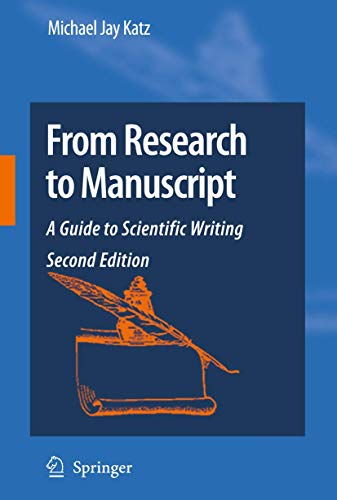From Research to Manuscript: A Guide to Scientific Writing - Softcover

Zu dieser ISBN ist aktuell kein Angebot verfügbar.
Alle Exemplare der Ausgabe mit dieser ISBN anzeigen:Die Inhaltsangabe kann sich auf eine andere Ausgabe dieses Titels beziehen.
"Compulsory reading for post-docs wanting to achieve success in the scientific field." (Ronan Bree, National University of Ireland, Galway)
"A great addition to the personal libraries of graduate students and postdoctoral fellows bent on careers in science. Many seasoned scientists could also be advised to read the book to improve their skills in writing." (Donald K. Ingram, Editor-in-Chief of AGE)
"Overall, Katz provides a pleasant overview of the research-science report process for both first-time science research authors and seasoned professionals." (Julie Kinyoun, Technical Communication, Vol. 54 (2), 2007)
"... another excellent book to treasure." (Dr. Achuthsankar S. Nair, University of Kerala)
This systematic writing guide teaches readers how to turn their research into a thorough, well-written science article. This updated edition includes more examples, advice on publishing in online journals, software suggestions and updated references.
„Über diesen Titel“ kann sich auf eine andere Ausgabe dieses Titels beziehen.
- VerlagSpringer
- Erscheinungsdatum2009
- ISBN 10 1402094663
- ISBN 13 9781402094668
- EinbandTapa blanda
- Anzahl der Seiten224
- Bewertung
Neu kaufen
Mehr zu diesem Angebot erfahren
Versand:
EUR 32,99
Von Deutschland nach USA
Beste Suchergebnisse beim ZVAB
From Research to Manuscript : A Guide to Scientific Writing
Buchbeschreibung Taschenbuch. Zustand: Neu. Druck auf Anfrage Neuware - Printed after ordering - Observations Plus Recipes It has been said that science is the orderly collection of facts about the natural world. Scientists, however, are wary of using the word 'fact. ' 'Fact' has the feeling of absoluteness and universality, whereas scientific observations are neither ab- lute nor universal. For example, 'children have 20 deciduous [baby] teeth' is an observation about the real world, but scientists would not call it a fact. Some children have fewer deciduous teeth, and some have more. Even those children who have exactly 20 deciduous teeth use the full set during only a part of their childhood. When they are babies and t- dlers, children have less than 20 visible teeth, and as they grow older, children begin to loose their deciduous teeth, which are then replaced by permanent teeth. 'Children have 20 deciduous [baby] teeth' is not even a complete scientific sta- ment. For one thing, the statement 'children have 20 deciduous teeth' does not tell us what we mean by 'teeth. ' When we say 'teeth,' do we mean only those that can seen be with the unaided eye, or do we also include the hidden, unerupted teeth An observation such as 'children have 20 deciduous teeth' is not a fact, and, by itself, it is not acceptable as a scientific statement until its terms are explained: scientifically, 'children have 20 deciduous teeth' must be accompanied by definitions and qualifiers. Artikel-Nr. 9781402094668
Weitere Informationen zu diesem Verkäufer | Verkäufer kontaktieren

